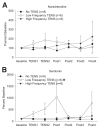Increased release of serotonin in the spinal cord during low, but not high, frequency transcutaneous electric nerve stimulation in rats with joint inflammation
- PMID: 16876561
- PMCID: PMC2746636
- DOI: 10.1016/j.apmr.2006.04.023
Increased release of serotonin in the spinal cord during low, but not high, frequency transcutaneous electric nerve stimulation in rats with joint inflammation
Abstract
Objective: To determine the release pattern of serotonin and noradrenaline in the spinal cord in response to transcutaneous electric nerve stimulation (TENS) delivered at low or high frequency.
Design: Prospective randomized allocation of 3 treatments.
Setting: Research laboratory.
Animals: Male Sprague-Dawley rats (weight range, 250-350 g).
Intervention: Knee joints of rats were inflamed with a mixture of 3% carrageenan and 3% kaolin for 24 hours prior to placement of push-pull cannulae into the dorsal horn of the spinal cord. Push-pull samples were collected in 10-minute intervals before, during, and after treatment with low-frequency TENS (4 Hz), high-frequency TENS (100 Hz), or sham TENS. TENS was applied to the inflamed knee joint for 20 minutes at sensory intensity and 100-mus pulse duration. Push-pull samples were analyzed for serotonin and noradrenaline by high performance liquid chromatography with coulemetric detection.
Main outcome measures: Spinal concentrations of serotonin and noradrenaline.
Results: Low-frequency TENS significantly increased serotonin concentrations during and immediately after treatment. There was no change in serotonin with high-frequency TENS, nor was there a change in noradrenaline with low- or high-frequency TENS.
Conclusions: Low-frequency TENS releases serotonin in the spinal cord to produce antihyperalgesia by activation of serotonin receptors.
Figures

References
-
- Wall PD, Sweet WH. Temporary abolition of pain in man. Science. 1967;155:108–9. - PubMed
-
- Sjolund BH, Eriksson MB. The influence of naloxone on analgesia produced by peripheral conditioning stimulation. Brain Res. 1979;173:295–301. - PubMed
-
- Woolf DJ, Barrett GD, Mitchell D, Myers RA. Naloxone-reversible peripheral electroanalgesia in intact and spinal rats. Eur J Pharmacol. 1977;45:311–4. - PubMed
-
- Sluka KA, Deacon M, Stibal A, Strissel S, Terpstra A. Spinal blockade of opioid receptors prevents the analgesia produced by TENS in arthritic rats. J Pharmacol Exp Ther. 1999;289:840–6. - PubMed
-
- Kalra A, Urban MO, Sluka KA. Blockade of opioid receptors in rostral ventral medulla prevents antihyperalgesia produced by transcutaneous electrical nerve stimulation (TENS) J Pharmacol Exp Ther. 2001;298:257–63. - PubMed
Publication types
MeSH terms
Substances
Grants and funding
LinkOut - more resources
Full Text Sources

